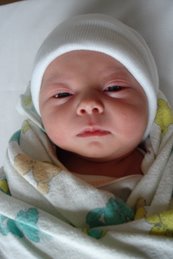On Saturday, Aaron, Tiffany, and I climbed Mount Fuji, the tallest mountain in Japan, a mostly mountainous country full of people who—despite living and working in modern, dirty, noisy cities—imagine themselves in their truest identities as wayfarers hiking along high ridges and breathing the cool, dry mountain air of the countryside, much like all of us Americans working in offices who fantasize about living the rugged life of a cowboy on the open range or of a salty fisherman bounding across the ocean swells. In part because of this cultural identification with the landscape, Fuji-san has been traditionally highly venerated as a symbol of Japan, depicted in art for centuries.
We could easily recognize this cultural heritage in the sheer number of people out on the mountain and their range of ages from grade school kids to grandparents, but we were also surprised by the very modern development of the mountain, the industrial and commercial activity all the way to the top. I had heard that there were "tea houses" along the trail, so I'd pictured rustic huts with Japanese architectural elements, very quiet, simple, and calm. In reality, they were more like extra large garden sheds with generators keeping the power running for the vending machines and concession area, where you could buy candy, soup, beer, soda, film, cigarettes, and a lot of other stuff. Some of these stations also served as bunk houses for overnight hikers planning to reach the summit in the early morning in order to see the sunrise.
We were hiking on a day trip, so we started at about 8 a.m. after driving a little less than two hours from Tokyo to the trail head halfway up the mountain. We reached the top by noon, ate lunch, walked around the crater to the true summit, then headed back down, reaching the parking lot and shops by around 3:45 p.m. It was all very civilized, and very unlike any mountain-climbing experience in North America, where there is so much emphasis on maintaining the pristine, natural beauty of the mountain. I can't imagine a government agency seeking to build (or overcoming public resistance to building) a large weather station at the very summit of Mt. Hood or Mt. Rainier, for example, yet that's what we found at the top of Mt. Fuji. Still, all this human activity and commerce made the Fuji climb uniquely enjoyable. We had a great time.
Enough rambling. Below are the edited highlights of the climb, from start to finish, in three chunks. First, from the parking lot at around 7,500 feet to around 10,000 feet:
Next, from around 10,000 feet to the rim of the crater at the top:
Finally, around the crater to the true summit at 12,388 feet, then heading home:
Subscribe to:
Post Comments (Atom)


No comments:
Post a Comment